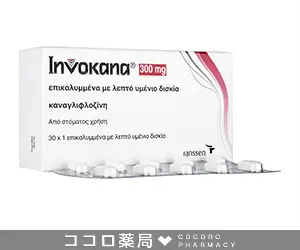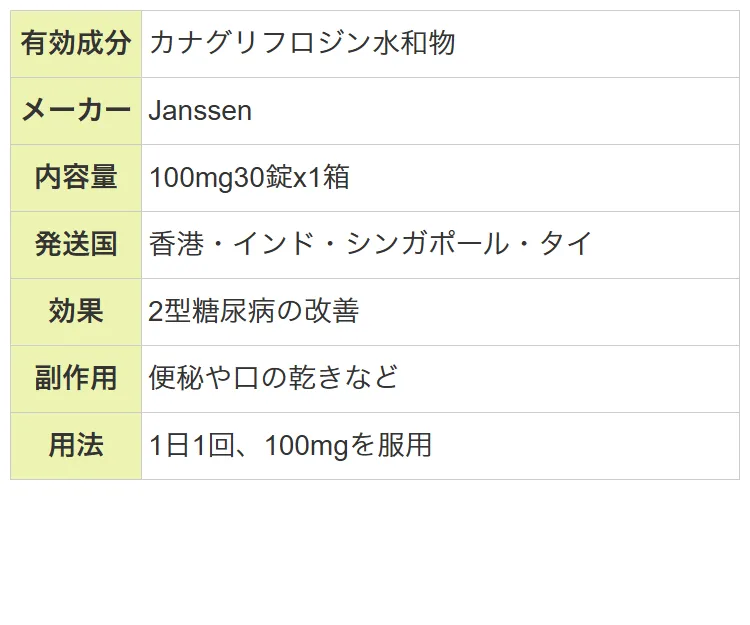2型糖尿病と診断され服用し始めました。血糖値のコントロールが良くなっただけでなく体重も減少し始め驚いています。これは薬だけではなく食事制限と運動をはじめたからかも。

左記クレジットカード、銀行振込、コンビニ決済に対応


更新日:2025/6/25

| 個数 | 販売価格(1箱あたり) | 販売価格(箱) | ポイント | 購入 |
|---|---|---|---|---|
| 1箱 | 12,460円 | 12,460円 | 373pt |






①1万円以上で送料無料
1回の注文で10,000円以上だった場合、1,000円の送料が無料となります。
まとめ買いをすると1商品あたりのコストパフォーマンスが高くなるためおすすめです。
②プライバシー守る安心梱包
外箱に当サイト名や商品名が記載されることはないため、ご家族や配達員など第三者に内容を知られることは御座いません。

③100%メーカー正規品取り扱い
当サイトの商品は100%メーカー正規品となっており、第三者機関による鑑定も行っております。
商品の破損などがあった場合は再配送などにて対応させて頂きますので、ご連絡頂ければ幸いです。

④いつでも購入可能 処方箋不要
サイト上では24時間いつでもご注文を受けております。
また、お電話によるご注文も受け付けておりますのでネットが苦手な方はお気軽にどうぞ。

⑤商品到着100%
商品発送後はお荷物の追跡状況が分かる追跡番号をご案内させて頂きます。
郵便局には保管期限がありますのでご注意ください。
・自宅配達で不在だった場合の保管期限・・・16日間前後
・郵便局留めとした場合の保管期限・・・7~30日間

⑥コンビニ決済利用可能
ご近所のコンビニにていつでもお支払可能です。
セブンイレブンに限り店舗での機械操作を必要とせず、手続き完了後に表示されるバーコードや払込票番号をレジに提示することでお支払い頂けます。

インボカナ 300mg30錠 x 1箱
12,460円
ポイント:373pt
10,000円以上購入で送料無料
在庫あり

2型糖尿病と診断され服用し始めました。血糖値のコントロールが良くなっただけでなく体重も減少し始め驚いています。これは薬だけではなく食事制限と運動をはじめたからかも。
糖尿病は動脈硬化などを引き起こす恐れがあります。食事療法や運動療法で血糖を下げることも可能ですが、治療薬を使用することでより効率的に糖尿病の改善が可能です。
糖尿病治療薬の副作用として眠気などが報告されている種類のものはありません。そのため、眠気などが起きたような場合には別の原因が考えられます。
糖尿病治療薬の服用で性格が変わるといったことはありません。糖尿病治療薬は種類にもよりますが、脳に対して作用したりすることはないため、性格が変わるといった可能性は限りなくゼロに近い考えられます。
糖尿病薬は血糖を下げる作用がありますが、運動療法や食事療法を組み合わせることは非常に重要です。それらを組み合わせることでより効率的に糖尿病を改善することができるため、適切に運動や食事療法を取り入れるようにしましょう。
基本的に糖尿病治療薬は血糖値が運動や食事療法だけで抑えられるれ、それを維持できると判断されれば辞められる場合があります。ですが、食事や運動でも足りない場合には、継続が必要です。そのため、糖尿病治療薬の継続は自身の血糖値によって判断されます。
糖尿病の薬は血糖値を低下させる作用を持っています。そのため、健康で血糖値が高くない人が飲んでしまうと、必要な血糖値を維持できず意識障害などを引き起こしてしまう可能性があります。また、意識障害から死に至るといった可能性もあります。絶対に死ぬというわけではありませんが、危険であるため、健康な方は治療薬の服用はお避け下さい。
ダイエット目的で糖尿病の治療薬を服用することは非常に危険です。もともと、血糖値が正常な人が糖尿病治療薬によって過度な低血糖となってしまい死に至る可能性もあります。また、痩せる可能性があるのはごく一部の治療薬のみとなっています。そのため、ダイエットを目的としての使用は厳禁です。
食前に服用しても問題ない種類のものも、食後にしか服用していけないものもあります。そのため、自身の服用している糖尿病の種類をご確認の上、医師や薬剤師に確認するようにして下さい。
| 1日の服用回数 | 1回 |
|---|---|
| 1回の服用量 | 100mg |
| 服用のタイミング | 朝食前か後 |
| 服用間隔 | 指定なし |
| 商品名 | グルコバイ | リベルサス | ゾメット(メトグルコジェネリック) | ノボノーム | メトホルミンジェネリック | グリベンクラミド | イスタメット | マトフィンXR |
|---|---|---|---|---|---|---|---|---|
| 商品画像 |  |  |  |  |  |  |  |  |
| 特徴1 | 食後の血糖値急上昇を防ぐ | 日本で承認済みなので安全性は高い | ・体重増加を起こしにくい | ・従来品よりも膵臓のβ細胞への負担が少ない | ・糖の新生を抑制して血糖を下げる | ・よく使われている血糖降下薬の成分を配合 | ・相乗効果によって血糖値をコントロールする | ・体重増加を助長する心配をせずに使える |
| 特徴2 | 世界的な製薬メーカー、バイエル(Bayer)が製造 | 体重減少効果も報告されている | ・後発医薬品だから低価格 | ・シュアポストと同じ成分が配合されている | ・インスリン分泌薬で効果がなくても使える治療薬 | ・第2世代のスルホニル尿素系薬剤 | ・体重増加を助長する心配の少ない成分を配合 | ・膵臓でのインスリン分泌を介さずに作用する |
| 内容量 | 50mgx90錠 | 3mg10錠x1箱 | 500mgx100錠 | 0.5mg30錠x1箱 | 850mgx60錠 | 2.5mg100錠x1箱 | 50mg/500mgx30錠 | 500mg100錠x1箱 |
| 価格 | 2,700円 | 9,800円 | 4,000円 | 3,960円 | 9,760円 | 5,460円 | 6,960円 | 5,160円 |
本製品は海外製のため、期限表記が日本と異なる場合がございます。
パッケージ裏面や側面、シートなどに以下のような表記がされています。
| EXP | 使用期限 例:EXP 12/2025→2025年12月まで使用可 |
|---|---|
| MFG または MFD | 製造日 例:MFG 03/2023 |
| BEST BEFORE | 品質が最も安定している目安日 |


※国や製品により日付の並び(例:月/年、日/月/年)が異なる場合がありますのでご注意ください
EXP(Expiry Date) の表記がなく、MFG または MFDしか記載がないケースがあります。
この場合は MFG(MFD) から2~3年が使用期限の目安です。
※「LOT」や「BATCH」の表記は製造番号であり期限ではありません。

パッケージ例となります。
商品やご注文単位によってはシート単位でのお届けとなる場合が御座います。
外箱に当サイト名や商品名が記載されることはないため、ご家族や配達員など第三者に内容を知られることは御座いません。
尿と一緒に糖を排出するタイプの薬なので、飲み始めてから尿のにおいが変わったのが分かる。その分、しっかり効果が出ているという安心感はあるけれど、トイレが近くなるので外出時は少し不便を感じることも。体調は安定しているので、うまく付き合いながら使っていくつもり。
食事制限をしなくても少しずつ体重が落ちてきていてその点は満足。ただ以前よりも口が渇きやすくなり、肌の乾燥も感じるようになった。水分をしっかり取るようにしているが冬場は特に注意が必要だと感じた。
毎朝1回の服用で済むので忘れにくく続けやすいです。血糖値も安定し安心して生活できるようになりました。この調子で維持していこうと思います。
2型糖尿病と診断され服用し始めました。血糖値のコントロールが良くなっただけでなく体重も減少し始め驚いています。これは薬だけではなく食事制限と運動をはじめたからかも。
1日1回の服用で血糖値が安定し、体重も減少傾向にあります。副作用もほとんど感じず、あの独特な臭いのおしっこもしなくなりました。これからもこの薬を活用していきます。
商品口コミの投稿は会員のみ行えるようになっております。
お手数ですが会員ログインの上でご投稿頂きますようお願いいたします。
口コミをご投稿頂いたお客様にはポイントをプレゼントさせて頂いております。
文章のみであれば100ポイント、文章+写真付きのものは300ポイントをプレゼントさせて頂きます。
規約や詳細などはこちらをご確認くださいませ。